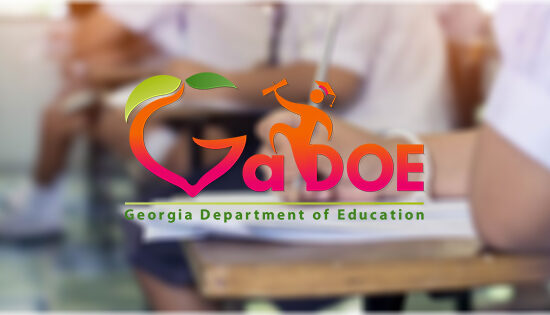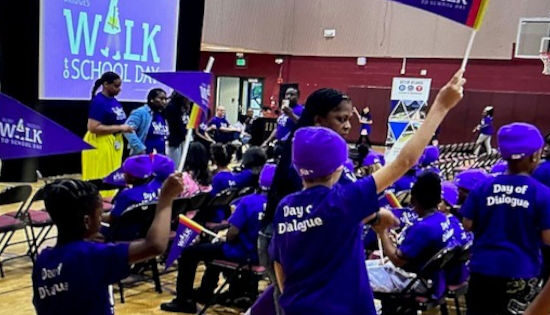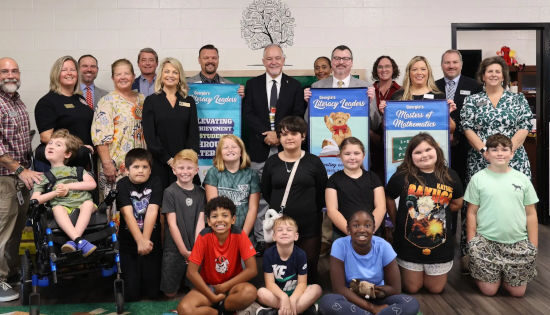ATLANTA – Georgia school district stories show the power of relationships and relevance in student learning with the CCRPI.
Release:

Baker County Schools: “Win, lose, or draw, I’m here to support you”
In Baker County Schools, teachers worked to unpack the new mathematics standards, weave in writing across the curriculum, increase student engagement, and bring the community into the classroom. Ultimately, it was the relationships they built with students that made the biggest difference.
Baker County, a small district enrolling just over 300 students in southwest Georgia, saw gains in Content Mastery across all grade bands – with an 8.8-percentage-point gain in middle school.
Teachers and leaders worked to understand and implement the new math and ELA standards, using the learning plans provided by GaDOE and training from Southwest Georgia RESA. Math teacher Gail Hawkins found the new K-12 Mathematics Standards, first implemented during the 2023-2024 school year, helped her students go beyond surface-level instruction through their focus on problem-based learning.
Districtwide, teachers worked to blend literacy and writing into all subject areas. In math, Hawkins’ students expressed the reasoning behind their answers in writing – sharpening their ability to analyze and evaluate information. In social studies, Ashley Davis – the district’s Teacher of the Year – ensured all assessments included open-ended questions, and focused on inquiry-based learning. Davis’ students researched concepts, completed guided readings, reviewed primary sources and documents – and, Davis said, “did a lot of writing.”
“Being able to do that helped them realize that they do know the content,” Davis said. “They don’t have to second-guess themselves – they worked so hard to learn it.”
The district also focused on building students’ engagement in learning. ELA teacher Ossie Canidate, for example, still dove into classic literature with her students – but she also found modern texts that would draw their interest. And teachers and leaders redoubled their efforts to partner with the community – including through a mentoring program that pairs students in need of additional motivation and encouragement with community mentors.
“We have to find ways to make school fun for them,” Principal Jeff Henderson said. “Sometimes they have so much going on outside of school – but we can create an environment where students want to be here, and our teachers do a great job of making learning meaningful to them.”
At the end of the day, though, it was relationships that made the difference. Students realized their teachers were serious about their learning – and cared about them as people, too. Teachers encouraged their students to engage in extracurricular activities and showed up to cheer them on when they did.
“I tell them, when you hear your name called, you know that’s Mrs. Hawkins calling your name,” Hawkins said. “Win, lose, or draw, I’m here to support you.”

Bibb County Schools: “Turn your numbers into names”
In Bibb County Schools, teachers and leaders embraced personalized learning – which helped lead to a 5.5-percentage-point gain in Content Mastery for the district’s high schools.
Personalized learning is an approach that tailors instruction to each student’s needs and interests, rather than a one-size-fits-all model. Students take ownership of their education by setting goals, tracking their progress, and reflecting on their growth. They’re taught that learning never stops.
“As we got closer and closer to the assessment, confidence brewed,” Southwest High School Principal Bernard Young said. “Students went into the test really understanding, really knowing, ‘I can do my best. I am prepared, because I’ve seen myself grow from day one until the end.’”
School leaders also focused on strengthening collaboration between teachers. At Howard High School, Principal Michael Scott led teams of teachers to prepare for student learning and evaluate the quality of student work, with a focus on instructional clarity.
“Our two big focus areas are clarity and trust – clarity on what we’re trying to achieve, how we’re going to achieve it, and how we’re going to collaborate together to do that,” Scott said. “It’s clarity, trust, and teacher voice, because they are a huge factor in student outcomes and we want to make sure we’re providing the support they need.”
Bibb schools focused on building relationships with families – meeting them where they are, from the school building to the ball field – and ensuring they were aware of the opportunities available to their students.
Finally, school leaders focused not on “teaching to the test,” but on excellent instruction – confident that results would follow.
“You have to change the narrative,” said Young, the Southwest High School principal. “It’s not about the test. Stop talking tests and start talking about building and growing individuals. Once you start talking about building and growing individuals – from growing your students to achieve higher outcomes, to providing learning for your teachers – the data’s going to take care of itself. But if you go straight to attacking test scores, you’re never going to get it.”
Scott, the Howard High School Principal, agreed.
“You have to turn your numbers into names,” he said. “We’re all looking at data points all day, but these are real human beings. In our data team meetings, we call our students by name. We know where they are, and what barriers are in the way that we need to remove to get to the next level. Our students are real human beings. They have an identity. That’s who we’re working with every day.”

Calhoun County Schools: Setting expectations and watching students excel
In Calhoun County Schools, leaders worked to strengthen supports for standards-aligned learning at the classroom level – while bringing those standards to life for students through hands-on activities.
Those efforts resulted in strong Content Mastery gains across grade bands – 11.8 percentage points in the elementary grade band, 7.1 points for middle school, and 12.4 points for high school.
Leaders implemented regular district walkthroughs, with a focus on instructional quality and immediate feedback for teachers. Using tools they gained while working with GaDOE’s Office of School and District Improvement, leaders placed a priority on planning and preparation, and worked to decrease the variability of learning between classrooms.
Students had access to back-to-back instructional and intervention periods, along with extended learning time. Teachers focused on building student engagement and integrating hands-on learning – from the use of manipulatives in mathematics to science stations to real-world connections in biology. The goal was always to prepare students for their futures.
Superintendent Pamela Quimbley, who was previously an elementary school principal and has known many of her graduates and soon-to-be graduates throughout their entire educational careers, described her desire to ensure students graduate on a pathway to success.
“Either they will become employed, they will enroll in a postsecondary institution, or they will enlist in the military,” Quimbley said. “That is the vision I have for our students – for them to become productive citizens.”
In Calhoun County, that starts with showing students their teachers care about individuals. High school math teacher Jessica Haynes described the way her students gradually “buy in” once they learn she cares about them and their ability to learn. Once that foundation is in place, she was able to set high expectations – and watch students exceed them.
“It’s, ‘let me not allow you to just do the bare minimum,’” Haynes said. “I set expectations for them, and they met me there. They were willing to meet me there.”

Henry County Schools: “Who they’re going to be” – connecting students to positive purpose
In Henry County Schools, educators focused on student achievement and wellbeing in tandem – anchored by the goal of helping every student find purpose to guide their learning.
This led to gains in Content Mastery across grade bands, with a 4.9-percentage-point gain for the district’s elementary schools.
“I have tasked our schools, our teachers, our principals, with helping our students find a positive purpose,” Superintendent Dr. John Pace said. “What’s their positive purpose in life? If we can help them find that, the pathway to learning becomes easy. They’re able to connect.”
Both Superintendent Pace and Sophe Pope, Chair of the Henry County Board of Education, credited the district’s progress to its shared focus and unified governance team.
“We have really seen the incredible impacts of a unified governance model here in Henry County,” Pope said. “We’re making a direct connection between the community’s voice – through our strategic plan that is a living, breathing document – to the boardroom, and then to every single classroom across our district. When this team in Henry County focuses on something, great things happen.”
Schools across the district focused on building the conditions for learning. At Austin Road Middle School, that meant tailoring instruction to the needs of every student.
“We worked to pinpoint exactly what each kid needed that day, that week, that unit,” Principal Libra Brittian said. “Instead of creating one-size-fits-all lessons, we tailored instruction so every student could make progress at their own pace.”
At Unity Grove Elementary School, Principal Dr. Elyse Durden focused on extending time for teachers to prepare for strong instruction.
“We have to take care of our teachers,” Dr. Durden said. “We make sure our master schedule includes expansive time for them to plan. Our entire schedule is built around ensuring our students have time to learn and, in order to do that, our teachers need time to plan. So, we very strategically schedule so our teachers have more planning time than they ever have.”
Schools also worked to engage students – put simply, they made sure every student had a reason to be in school. At Stockbridge High School, every teacher leads a club – including the principal, Dr. James Thornton, who leads a personal finance club. It’s a strategy that’s boosted student attendance and helped students connect learning with their interests and goals, Dr. Thornton explained.
At Oakland Elementary School, a close alignment between the Georgia science standards and Science, Technology, Engineering, and Math (STEM) practices gives students “a double dose of hands-on, interactive engagement,” Principal Andre Johnson said.
This all culminates in a system of schools that are connecting students, even as early as elementary school, with the goals they’ll pursue in the future.
“Students have to have a place here at school,” said Dr. Durden, the Unity Grove Elementary principal. “This is where they learn what they want to be. I think most people can tell you – especially educators – what teacher made them want to be a teacher. And while I would love to be creating all kinds of future educators, we also have future doctors, analysts, businesswomen and businessmen and all kinds of professions that aren’t even in existence yet, all sitting in our classrooms right now. So, how can we help them find what interests them? How can we help them find who they’re going to be?”










